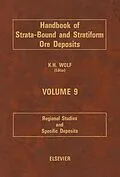Handbook of Strata-Bound and Stratiform Ore Deposits, Volume 9: Regional and Specific Deposits focuses on the processes, methodologies, principles, and approaches involved in the identification of regional and specific ore deposits.
The selection first elaborates on the timing of mineralization in stratiform copper deposits, oolitic iron formations, and metalliferous deep-sea sediments. Discussions focus on marine distribution and nature of surface and near-surface deposits, structural setting and associated deposits, principal types of deep-sea metal-enriched sediments, chronological development of oolitic-inland-sea iron formation, and complementary sources and transport mechanisms.
The text then tackles heavy-metal accumulation in limnic sediments, trace metals in fresh waters, nature and origin of Archaean strata-bound volcanic associated nickel-iron-copper sulphide deposits, and the significance of pyritic black shales in the genesis of Archean nickel sulphide deposits. Topics include lithological associations, oxidation and supergene alteration of ores, temporal and tectonic setting, dissolved metal concentrations in large freshwater systems, and transport phases of heavy metals in river water. The publication examines strata-bound tin deposits, geology of the Pine Point lead-zinc district, and genesis of the Rammelsberg ore deposit near Goslar/Upper Harz in the Federal Republic of Germany.
The selection is a valuable reference for researchers wanting to explore ore deposits.
Inhalt
Chapter 1. The Timing of Mineralization in Stratiform Copper Deposits
Introduction
Criteria for Post-Sedimentary Mineralization at White Pine, Michigan
Configuration of the Mineralized Zone
Mineralogy
Seal Lake, Labrador
Creta, South-Central U.S.A
The Kupferschiefer, North-Central Europe
Central African Copperbelts
The Zambian Copperbelt
The Shaban Copperbelt
Other Deposits
Complementary Sources and Transport Mechanisms
Concluding Remarks
Acknowledgements
Appendix - Usage of Some Descriptive and Genetic Terms in this Chapter
References
Chapter 2. Oolitic Iron Formations
Introduction
Chronological Development of Oolitic-Inland-Sea Iron Formation
Precambrian Oolitic-Inland-Sea Iron Formation
Paleozoic Oolitic-Inland-Sea Iron Formation
Mesozoic Oolitic-Inland-Sea Iron Formation
Tertiary Oolitic-Inland-Sea Iron Formation
Tertiary Oolitic-Inland-Sea Iron Formation of Colombia and Venezuela
Introduction
Stratigraphy of the Paz de Rio Area, Colombia
General Features of the Paz de Rio Iron Formation
Mineralogy of the Paz de Rio Iron Formation
Petrography of the Paz de Rio Iron Formation
Chemistry of the Paz de Rio Iron Formation
Sedimentary Environment of the Paz de Rio Iron Formation
Sabanalarga Oolitic-Inland-Sea Iron Formation
Proposed Origin of Oolitic-Inland-Sea Iron Formations
Statement of the Problem
Outline of the Genetic Model
Evaluation of the Genetic Model
Evidence for the Genetic Model
Previous Arguments Against Related Genetic Models
Other Genetic Models for Oolitic-Inland-Sea Iron Formations
Constraint on Sedimentation Rate
Hypothesis of Marine Iron Supply
Hypotheses of Fluvial Iron Supply
Hypotheses of Lateral And Upward Groundwater Supply of Iron
Miscellaneous Hypotheses
Proposed Modern Lacustrine Ferriferous Oolite
Relevant Quaternary Carbonate Ferruginization
Possible Implications of the Genetic Model
References
Chapter 3. Metalliferous Deep-Sea Sediments
Introduction
Background
Metal Source and Composition
Economic Significance and Related Ores
Principal Types of Deep-Sea Metal-Enriched Sediments
Carbonaceous Sediments
Metalliferous Sediments
Nature of Metal-Bearing Phases
Iron Oxide Phases
Iron Smectite Phase
Sulphide Phases
Manganese Oxide Phase
Other Phases
Size Fractionation and Chemical Leaching of the Iron Phases
Marine Distribution and Nature of Surface and Near-Surface Deposits
East Pacific Rise
Iron in East Pacific Rise Sediments
Bauer Deep
Galapagos Spreading Centre
Northeastern Pacific
Southwestern Pacific Basin
Mid-Atlantic Ridge
Indian Ocean
Red Sea
Submarine Volcanic Vents
Marine Distribution and Nature of Basal Deposits
Pacific Ocean
Atlantic Ocean
Indian Ocean
Sediment Chemistry
Compositional Variation
Metal Accumulation Rates
Structural Setting and Associated Deposits
Transform Fault Valley "A", Famous Area of Mid-Atlantic Ridge
Tag Geothermal Area, North Atlantic
Red Sea
Ophiolite Sequences
Massive Sulphide Ores
Origin
Significance to Geochemical Exploration for Ores
Summary
Acknowledgments
References
Chapter 4. Recent Heavy-Metal Accumulation in Limnic Sediments
Introduction
Recent Sedimentary Environments of Metal Accumulation
Lake Sediments
Major Factors of Metal Accumulation in Recent Limnic Sediments
Metal Distribution in Recent Lacustrine Sediments
Geochemical Background Values for Freshwater Sediments
Allochthonous Influences on the Heavy-Metal Composition in Recent Lacustrine Sediments
Grain-Size Effects
Natural Allochthonous Influences
Man's Impact on Metal Distribution in Limnic Sediments
Lake Sediments as Indicators of Metal Pollution
Geochemical Reconnaissance of Limnic Sediments
Autochthonous Processes Affecting Metal Concentrations in Recent Limnic Sediments
Dilution of Heavy Metals by Endogenic Minerals in Lake Sediments
Heavy-Metal Accumulation in Endogenic Phases of Lake Sediments
Diagenetic Effects on Metal Accumulation in Limnic Sediments
Phases of Heavy-Metal Accumulation in Limnic Sediments
Extraction of Different Chemical Phases of Heavy Metals
Separation of Heavy-Metal Associations with Fe and Mn Hydroxides
Evaluation of Diagenetic Effects on Metal Phases in Limnic Sediments
Extraction of Trace Metals from Carbonates
Metal Bonding on Organic Material
Metal Associations in Less-Polluted Lake Sediments
Metal Phases in Contaminated Dredged Sediments
Grain-Size Variations of Chemical Phases
Phase Concentration Factors of Heavy Metals in Limnic Sediments
Release of Heavy Metals from Sediments
Conclusions
Acknowledgements
References
Note Added in Proof
Chapter 5. Trace Metals in Fresh Waters (with Particular Reference to Mine Effluents)
Introduction
Sources and Effects of Metals in Natural Waters
Water-Quality Criteria
Transport Phases of Heavy Metals in River Waters
Dependencies of Metal Transport from Water Discharge and Annual Cycles
Dissolved Metal Concentrations in Large Freshwater Systems
River-Sea Interface
Metal Enrichment in Mine Effluents
Conclusions
References
Chapter 6. The Nature and Origin of Archaean Strata-Bound Volcanic-Associated Nickel-Iron-Copper Sulphide Deposits
Introduction
Genetic and Economic Importance
Definition
Comparison with Other Deposits
Type Examples
Nature of Review
Temporal and Te…
